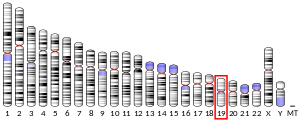Programmed cell death protein 5 is a protein, originally identified as an apoptosis-accelerating protein,[4] that in humans is encoded by the PDCD5 gene.[5][6]
This gene encodes a protein expressed in tumor cells during apoptosis independent of the apoptosis-inducing stimuli. Prior to apoptosis induction, this gene product is distributed in both the nucleus and cytoplasm.
Once apoptosis is induced, the level of this protein increases and by relocation from the cytoplasm, it accumulates in the nucleus. Although its exact function is not defined, this protein is thought to play an early and universal role in apoptosis.[6]
References
edit- ^ a b c GRCh38: Ensembl release 89: ENSG00000105185 – Ensembl, May 2017
- ^ "Human PubMed Reference:". National Center for Biotechnology Information, U.S. National Library of Medicine.
- ^ "Mouse PubMed Reference:". National Center for Biotechnology Information, U.S. National Library of Medicine.
- ^ Li G, Ma D, Chen Y (April 2016). "Cellular functions of programmed cell death 5". Biochimica et Biophysica Acta (BBA) - Molecular Cell Research. 1863 (4): 572–580. doi:10.1016/j.bbamcr.2015.12.021. PMID 26775586.
- ^ Liu H, Wang Y, Zhang Y, Song Q, Di C, Chen G, Tang J, Ma D (January 1999). "TFAR19, a novel apoptosis-related gene cloned from human leukemia cell line TF-1, could enhance apoptosis of some tumor cells induced by growth factor withdrawal". Biochemical and Biophysical Research Communications. 254 (1): 203–210. doi:10.1006/bbrc.1998.9893. PMID 9920759.
- ^ a b "Entrez Gene: PDCD5 programmed cell death 5".
Further reading
edit- Park SY, Hong JY, Lee SY, Lee SH, Kim MJ, Kim SY, Kim KW, Shim HS, Park MS, Lee CG, Elias JA, Sohn MH, Yoon HG (May 2021). "Club cell-specific role of programmed cell death 5 in pulmonary fibrosis". Nature Communications. 12 (1): 2923. Bibcode:2021NatCo..12.2923P. doi:10.1038/s41467-021-23277-8. PMC 8134485. PMID 34011956.
- Huang Y, Zhang J, Yang J (February 2022). "ATF3 drives cell senescence through TGFβ/Pdcd5 pathway in cardiac myocyte". International Journal of Cardiology. 348: 118. doi:10.1016/j.ijcard.2021.11.067. PMID 34856292. S2CID 244788447.
- Naz A, Zhang S, An L, Song Z, Zi Z, Wu J, Lai S, Mazhar H, Xu M, Chen Y, Zou Y, He L, Zhu H (December 2021). "Muscle-specific programmed cell death 5 deletion attenuates cardiac aging". International Journal of Cardiology. 345: 98–104. doi:10.1016/j.ijcard.2021.10.142. PMID 34710491. S2CID 239981053.
- Bonaldo MF, Lennon G, Soares MB (September 1996). "Normalization and subtraction: two approaches to facilitate gene discovery". Genome Research. 6 (9): 791–806. doi:10.1101/gr.6.9.791. PMID 8889548.
- Chen Y, Sun R, Han W, Zhang Y, Song Q, Di C, Ma D (December 2001). "Nuclear translocation of PDCD5 (TFAR19): an early signal for apoptosis?". FEBS Letters. 509 (2): 191–196. doi:10.1016/S0014-5793(01)03062-9. PMID 11741587. S2CID 26547410.
- Gevaert K, Goethals M, Martens L, Van Damme J, Staes A, Thomas GR, Vandekerckhove J (May 2003). "Exploring proteomes and analyzing protein processing by mass spectrometric identification of sorted N-terminal peptides". Nature Biotechnology. 21 (5): 566–569. doi:10.1038/nbt810. PMID 12665801. S2CID 23783563.
- Xu M, Cheng N, Gui L, Lai M, Wang Y, Xia D, Rui M, Zhang Y, Ma D (March 2004). "The 5'-upstream region of human programmed cell death 5 gene contains a highly active TATA-less promoter that is up-regulated by etoposide". Gene. 329: 39–49. doi:10.1016/j.gene.2003.12.025. PMID 15033527.
- Beausoleil SA, Jedrychowski M, Schwartz D, Elias JE, Villén J, Li J, Cohn MA, Cantley LC, Gygi SP (August 2004). "Large-scale characterization of HeLa cell nuclear phosphoproteins". Proceedings of the National Academy of Sciences of the United States of America. 101 (33): 12130–12135. Bibcode:2004PNAS..10112130B. doi:10.1073/pnas.0404720101. PMC 514446. PMID 15302935.
- Liu D, Yao H, Chen Y, Feng Y, Chen Y, Wang J (November 2005). "The N-terminal 26-residue fragment of human programmed cell death 5 protein can form a stable alpha-helix having unique electrostatic potential character". The Biochemical Journal. 392 (Pt 1): 47–54. doi:10.1042/BJ20050688. PMC 1317663. PMID 16083422.
- Stelzl U, Worm U, Lalowski M, Haenig C, Brembeck FH, Goehler H, Stroedicke M, Zenkner M, Schoenherr A, Koeppen S, Timm J, Mintzlaff S, Abraham C, Bock N, Kietzmann S, Goedde A, Toksöz E, Droege A, Krobitsch S, Korn B, Birchmeier W, Lehrach H, Wanker EE (September 2005). "A human protein-protein interaction network: a resource for annotating the proteome". Cell. 122 (6): 957–968. doi:10.1016/j.cell.2005.08.029. hdl:11858/00-001M-0000-0010-8592-0. PMID 16169070. S2CID 8235923.
- Ma X, Ruan G, Wang Y, Li Q, Zhu P, Qin YZ, Li JL, Liu YR, Ma D, Zhao H (December 2005). "Two single-nucleotide polymorphisms with linkage disequilibrium in the human programmed cell death 5 gene 5' regulatory region affect promoter activity and the susceptibility of chronic myelogenous leukemia in Chinese population". Clinical Cancer Research. 11 (24 Pt 1): 8592–8599. doi:10.1158/1078-0432.CCR-05-0039. PMID 16361542. S2CID 3094976.
- Yang YH, Zhao M, Li WM, Lu YY, Chen YY, Kang B, Lu YY (June 2006). "Expression of programmed cell death 5 gene involves in regulation of apoptosis in gastric tumor cells". Apoptosis. 11 (6): 993–1001. doi:10.1007/s10495-006-6714-6. PMID 16547588. S2CID 21178139.
- Olsen JV, Blagoev B, Gnad F, Macek B, Kumar C, Mortensen P, Mann M (November 2006). "Global, in vivo, and site-specific phosphorylation dynamics in signaling networks". Cell. 127 (3): 635–648. doi:10.1016/j.cell.2006.09.026. PMID 17081983. S2CID 7827573.
- Wang N, Lu HS, Guan ZP, Sun TZ, Chen YY, Ruan GR, Chen ZK, Jiang J, Bai CJ (August 2007). "Involvement of PDCD5 in the regulation of apoptosis in fibroblast-like synoviocytes of rheumatoid arthritis". Apoptosis. 12 (8): 1433–1441. doi:10.1007/s10495-007-0070-z. PMID 17468978. S2CID 21175365.


